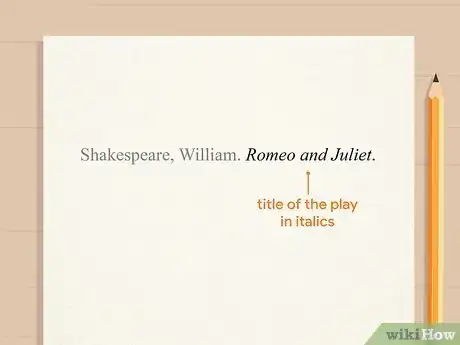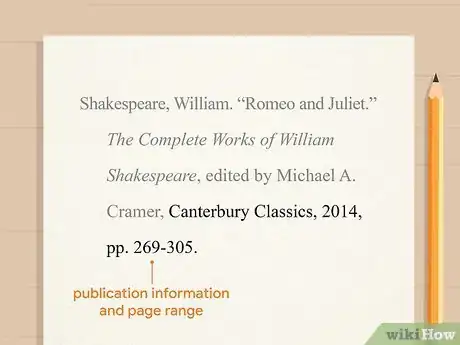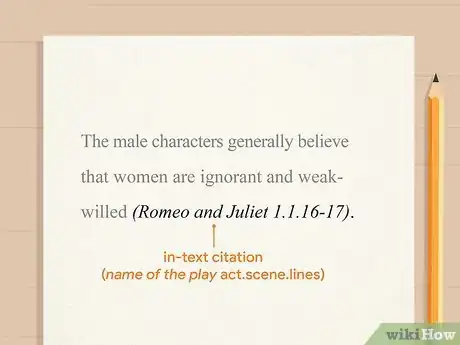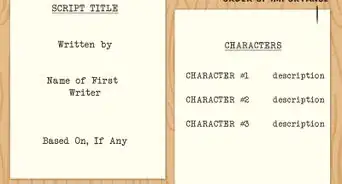This article was co-authored by wikiHow staff writer, Jennifer Mueller, JD. Jennifer Mueller is a wikiHow Content Creator. She specializes in reviewing, fact-checking, and evaluating wikiHow's content to ensure thoroughness and accuracy. Jennifer holds a JD from Indiana University Maurer School of Law in 2006.
This article has been viewed 14,634 times.
Learn more...
If you're writing a research paper, you might need to use a Shakespeare play, such as "Romeo and Juliet," as a source — particularly if you're writing a paper for a literature class. While Shakespearean plays are frequently included in anthologies and other books, the citation format for these plays differs from other works. The Modern Language Association (MLA), in particular, has a specific format that is only used when citing Shakespeare.
Steps
Works Cited Entry
-
1Start your entry with Shakespeare's name. As the author, Shakespeare is the first element of your Works Cited entry. List his last name first, followed by a comma, then add his first name. Place a period after his first name.[1]
- Example: Shakespeare, William.
-
2List the title of the play. If the copy of the play you're using as a source is a separate book, put the title in italics. On the other hand, if the play is included in an anthology of several Shakespearean plays, put the title in quotation marks. Use title case, capitalizing the first word and all nouns, pronouns, adjectives, adverbs, and verbs. Place a period at the end of the title, inside the closing quotation marks for an anthology.[2]
- Separate Book Example: Shakespeare, William. Romeo and Juliet.
- Anthology Example: Shakespeare, William. "Romeo and Juliet."
Advertisement -
3Include the editor of the edition for a separate book. If the play was published as a separate book, there typically is an editor who's credited with that edition. Use the words "Edited by" followed by their name in first name-last name format. Place a comma after the name.[3]
- Example: Shakespeare, William. Romeo and Juliet. Edited by Barbara Mowat,
-
4Provide the title and editor of the anthology, if applicable. If the play you accessed came from an anthology with several Shakespearean plays, type the title of the anthology in italics after the title of the play. Use title case, capitalizing the first word plus all nouns, pronouns, adjectives, adverbs, and verbs. Place a comma after the title, then add the words "edited by" followed by the name of the editor in first name-last name format. Place a comma after the editor's name.[4]
- Example: Shakespeare, William. "Romeo and Juliet." The Complete Works of William Shakespeare, edited by Michael A. Cramer,
-
5Close with publication information. List the name of the publishing company, followed by a comma, then add the year of publication. If the play is in a separate book, place a period after the year. If you're citing an anthology, place a comma after the year, then add the abbreviation "pp." and the page range where "Romeo and Juliet" appears. Place a period at the end.[5]
- Separate Book Example: Shakespeare, William. Romeo and Juliet. Edited by Barbara Mowat, Folger Library, 2004.
- Anthology Example: Shakespeare, William. "Romeo and Juliet." The Complete Works of William Shakespeare, edited by Michael A. Cramer, Canterbury Classics, 2014, pp. 269-305.
In-Text Citation
-
1Identify the act, scene, and lines in your parenthetical citation. For most sources, you provide the author and the page number in your MLA in-text citation. However, for Shakespeare, you list the number of the act, then the number of the scene, then the line or range of lines referenced. Each of these numbers is separated by a period without spaces in between. The parenthetical citation goes at the end of the sentence, inside the closing punctuation.[6]
- For example, you might write: Romeo and Juliet takes place in Verona, a city in Italy (1.1.2).
Tip: When you include the title of the play in your text, always italicize it to distinguish it from the two characters, Romeo and Juliet.[7]
-
2Add the name of the play to your parenthetical if it isn't evident from the text. Even if you don't include the title of the play in your text, your reader can infer which play you're talking about if you mention either Romeo or Juliet. Similarly, if your entire paper is about the play, [8]
- For example, you might write: The male characters generally believe that women are ignorant and weak-willed (Romeo and Juliet 1.1.16-17).
Tip: If you're going to use the title frequently, ask your instructor if you can use an abbreviation, rather than writing it out in full each time. The standard abbreviation for Romeo and Juliet is "Rom."[9]
-
3Use a forward slash to indicate new lines when quoting. Because Shakespearean plays are written in verse, you can't simply quote a line or two in prose without indicating the line breaks. At the end of a line, type a space, a forward slash, and another space. Then, type the following line.[10]
- For example, you might write: Shakespeare's mastery of the double entendre comes early in the play, when one character, discussing how he'll treat the young women of the rival family, states that he will cut off their heads. When his companion questions this, he says "Ay, the heads of the maids, or their maidenheads. / Take it in what sense thou wilt" (1.1.26-27).
References
- ↑ https://style.mla.org/epilogues-in-shakespeare-plays/
- ↑ https://lib.pstcc.edu/c.php?g=106731&p=693753
- ↑ https://style.mla.org/epilogues-in-shakespeare-plays/
- ↑ https://lib.pstcc.edu/c.php?g=106731&p=693753
- ↑ https://lib.pstcc.edu/c.php?g=106731&p=693753
- ↑ https://www.monmouth.edu/resources-for-writers/documents/mla-citing-drama.pdf/
- ↑ https://public.wsu.edu/~delahoyd/shakespeare/mla.html
- ↑ https://stpauls-mb.libguides.com/citations/shakespearemla
- ↑ https://lib.pstcc.edu/c.php?g=106731&p=693753





























































